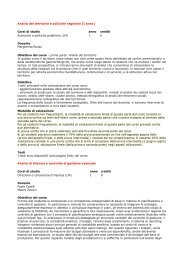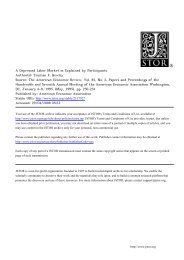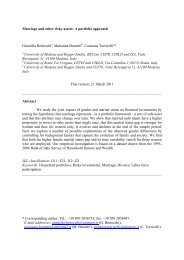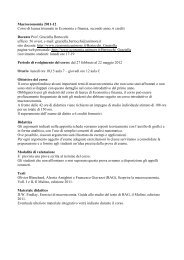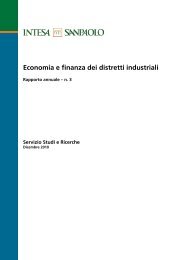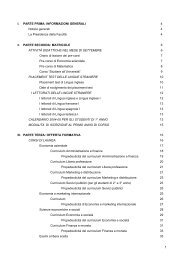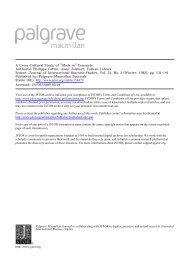You also want an ePaper? Increase the reach of your titles
YUMPU automatically turns print PDFs into web optimized ePapers that Google loves.
<strong>EJM</strong>41,7/8796manufacturing, designing, assembling, and producing parts for their products, hasbeen responsible for the introduction of more speci<strong>al</strong>ized terms, such ascountry-of-manufacture (Iyer and K<strong>al</strong>ita, 1997), country-of-design (Chao, 1998),country-of-assembly (Ahmed and d’Astous, 1996), and country-of-parts (Ulgado andLee, 1993). Country-of-origin is a complex phenomenon, which was found to affectproduct ev<strong>al</strong>uations at the country, product category, individu<strong>al</strong> product, or brandlevel (Bilkey and Nes, 1982; Al-Sulaiti and Baker, 1998). This may act as an intangibleinhibitor (or facilitator) for a firm to enter internation<strong>al</strong> mark<strong>et</strong>s, because of thenegative (or positive) bias toward certain imported goods by consumers residing inforeign countries (Wang and Lamb, 1983; Schooler <strong>et</strong> <strong>al</strong>., 1987).From an information theor<strong>et</strong>ic<strong>al</strong> perspective, consumers ev<strong>al</strong>uate a product on thebasis of both intrinsic (e.g. taste, design, fit) and extrinsic (e.g. price, brand, warranty)cues (Szybillo and Jacoby, 1974). Country-of-origin is regarded as an extrinsic cue – anintangible product attribute, which is widely used by consumers, especi<strong>al</strong>ly when theyhave only limited familiarity with products of foreign origin (Han, 1988; Han andTerpstra, 1988; Hanne, 1996). This is because, in the absence of information abouttangible traits of products, consumers tend to rely on extrinsic cues as indirectindicators of qu<strong>al</strong>ity and risk (Han, 1988; Papadopoulos and Heslop, 1993;Maheswaran, 1994). Hence, country-of-origin is not merely a cognitive cue –providing, for example, a sign<strong>al</strong> of product qu<strong>al</strong>ity, but is <strong>al</strong>so an affective one – with asymbolic and emotion<strong>al</strong> meaning, in the sense that it relates to the identity, pride, andmemories of consumers (Batra <strong>et</strong> <strong>al</strong>., 1999).Apart from cognitive and affective aspects, country-of-origin <strong>al</strong>so has normativeconnotations, in the sense that the consumer’s decision to purchase or avoid buying acountry’s products can be regarded as a vote in favor or against the policies, practices, oractions of a country (Verlegh and Steenkamp, 1999). In fact, consumers can reward“sympath<strong>et</strong>ic” countries by purchasing their products (buycott), but punish “antipath<strong>et</strong>ic”countries by refraining from buying their goods (boycott) (Smith, 1993). Another commons<strong>al</strong>ient norm of country-of-origin relates to the consumer’s inclination to purchasedomestic, as opposed to foreign, products, which is largely based on consumers’ judgmentof the mor<strong>al</strong>ity of purchasing foreign-made goods (Shimp and Sharma, 1987). This normis usu<strong>al</strong>ly harnessed by the “buy domestic” campaigns sponsored by governments,employers’ associations, and trade unions in sever<strong>al</strong> countries.The convergence of opinion among researchers in the field is that country-of-origineffects on product ev<strong>al</strong>uations can occur in two different ways: “h<strong>al</strong>o” and “summary”(Han, 1989). Under the “h<strong>al</strong>o” hypothesis, consumers make inferences about productqu<strong>al</strong>ity from the image they have of its country-of-origin, which in turn indirectly formspositive or negative consumer attitudes through product attribute rating (countryimage ! beliefs ! brand attitude). In the “summary” hypothesis, consumers makeabstractions of the product information into a country image[6], which subsequentlydirectly affects consumer attitude toward a brand (beliefs ! country image ! brandattitude). Thus, whatever the mechanism adopted, country-of-origin leads to a greatercognitive elaboration about tangible product attributes, thus shaping consumer attitudeand intention to purchase (Cordell, 1992; Verlegh and Steenkamp, 1999).Country-of-origin has a risk element, this being measured in terms of performance,financi<strong>al</strong>, or soci<strong>al</strong> risk associated with the purchase and use of the foreign product bythe consumer in the foreign country (Cordell, 1992; Amine and Shin, 2002; Ahmed <strong>et</strong> <strong>al</strong>.,






